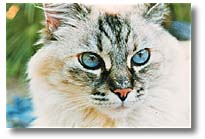Animal Photography
Get Good Pet Pictures
Text and Photos by June & Larry Allan
of Allan/The Animal Photographers

If you're like most photography enthusiasts, you're fond of taking pictures of animals -- domestic, as well as wild -- whenever you get the chance. If you have a fondness for them like we do, having devoted more than 20 years to photographing animals almost exclusively, you'll limit your "shooting" to the camera.
If you're lucky enough to share your home with a dog or cat, no doubt you've turned your camera in their direction while they scamper or sleep. Perhaps your photo success with your pet/companion has varied. Here are some useful tips that we can share based on our experience creating both formal (portrait) and candid (environmental) photographs of animals.
 What can I do to capture the texture of fur?
What can I do to capture the texture of fur?
Cross- or side-lighting helps bring out the texture of animal fur. To be even more specific, we prefer about a one-stop difference between our main light source (this could be the sun or a flash) which is lighting our subject from the side, and our fill light, which is positioned near the camera and aimed directly at the subject. You can achieve this 2:1 side-to-front, main-to-fill ration placing your lights at appropriate distances.
How do I get a good exposure on my black cat or dog to avoid "black blob" syndrome?
Open up your lens an extra stop -- or half-stop -- from the metered exposure. Try both variations to determine which is best for your subject. Black subjects, especially furry ones, simply do not reflect enough light to allow you to record shadow detail. The opposite applies to white animals -- close down the aperture by a full or half stop because white reflects all light waves, and white subjects tend to be overexposed.
 How do I avoid red eye (or green eye) when shooting animal photos?
How do I avoid red eye (or green eye) when shooting animal photos?
As with human subjects, the cause of this strange look is light from your flash being reflected off the retina and back out through the pupil of your subject's eyes. The simplest way to solve this problem is to get the flash head as far as possible from the axis of your lens. You can do this by using a flash bracket, holding your flash away from your camera or mounting lights so your subject's pupils will be smaller. You can also use your camera's built-in red-eye reduction system or shoot with a shorter focal length lens or at a wider zoom lens setting.
 How can I get animals to sit still for photographs?
How can I get animals to sit still for photographs?
Give your animal subjects something specific to look at or listen to at the moment of exposure. Once you do this, be ready to shoot. If you know your pet's routine and are sensitive to its moods, you can often anticipate the best time for portraits. Generally, you'll want your pet to be alert and attentive, neither tuckered out nor overly frisky.
LARRY ALLAN of Allan/The Animal Photographers in San Diego has been photographing animals exclusively for more than 20 years. His photos appear regularly around the world in magazines and books, on calendars and greeting cards, even on products and corporate logos. He has taught animal photography at professional photography schools and universities, written about it for many photography magazines and lectured about photographing animals at professional photographers' conventions.
Give your dogs back their mobility, try Nimble for Dogs
![]()
Desert Animal & Wildlife Index
Desert Photography Primer
Outdoor Recreation: Photograph
Related DesertUSA Pages
- How to Turn Your Smartphone into a Survival Tool
- 26 Tips for Surviving in the Desert
- Death by GPS
- 7 Smartphone Apps to Improve Your Camping Experience
- Maps Parks and More
- Desert Survival Skills
- How to Keep Ice Cold in the Desert
- Desert Rocks, Minerals & Geology Index
- Preparing an Emergency Survival Kit
Share this page on Facebook:
The Desert Environment
The North American Deserts
Desert Geological Terms



